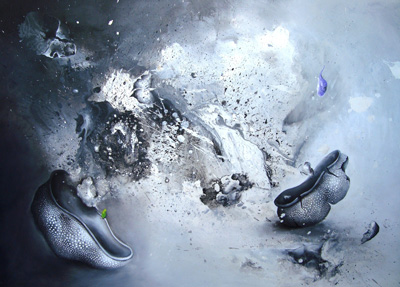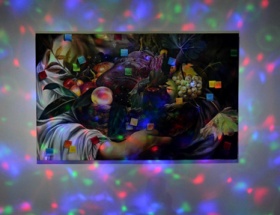[vc_row][vc_column][vc_column_text]
The Revelation of the Human
By Cassiel Martínez
The greatness of the artist consists in his ability to express existentiality and its nuances in an extraordinary way, capable of caressing the sensitivity of all those who contemplate his work, and loaded with an emotion that transcends itself; in his talent to build a language that, even transmitting a personal and intimate message, makes it collective and universal.
We find the Celtic peoples and the Nordic cultures, their icy environments and legendary battles distant and mythical. However, once again art shows the timelessness and the infinite capacity of meaning contained in the symbol.
Luis Orlando Álvarez ‘Pako’, in his series El viaje de Adán (Adam’sJourney) rescues elements of these civilizations to allow an introspective discourse to flow through them in which he pursues the unification of his internal cosmos, just like the Yggdrasil tree united the nine worlds in Nordic mythology.
In this series, deer and wolf, totemic animals of those ancient cultures, become personifications of human duality, of those internal and hidden forces that fight tirelessly to dominate the Being. Sometimes they want to destroy themselves; other times they dance, complement each other, sacrifice one another, hunt, braid, devour each other. They seek to reach the nucleus in which, merged into one unit, they succeed in becoming eternal and immortal.
The reddish and bluish tones, the use of different formats and sizes, underline the juxtaposition of states. Refrained environments, visually with Baroque and expressionist influences, and a brushstroke of romantic melancholy. The compositional and structural diversity of the pieces brings dynamism to the series. In the paintings, there is a struggle to escape towards the conquest of the volume; that is why the details are not incidental to the relief, textures and objects added to the canvas. The artist works metal (iron) by hand, which mimics the tradition of the Celtiberian peoples. He adds subtle autobiographical winks (he uses his own nails in one of the paintings, as part of the body in constant growth, and grants new meaning to a knife that belonged to his grandfather). In addition, he uses a wide range of materials, mostly telluric ones (coal, earth, wood), relying on the ancestral as starting point towards discovery.
In a world such as the current one, where technology dominates every moment of our day, where we build a staged existence for others, in which we are constantly exposed, focused on the image we project abroad and with very little space for an honest and deep introspection; in times like these, the presence of artistic discourses like Pako’s, which start from the primary need of the search, the unsettling question of where we are going, becomes essential; discourses in which the imperceptible thread that connects our incipient human being with the hero that ends his journey towards the conquest of himself and the communion with the Universe is appreciated.
His poetic and metaphorical titles, particularly symbolic in their full dimension, glimpse a personal imagery that transcends the visual effects and reaches a literary nuance. The artist accompanies some of his works with texts of his authorship, recreated in atmospheres similar to those of his pieces and with the participation of the same characters.
The anthropological background of these works allows him to connect and establish a link with each viewer, who beyond painted fables recognizes the presence of an intrinsically human message. The artist appeals to the unconscious from collective archetypes that we probably do not recognize until this moment, but that any of us is capable of translating and granting it a new meaning.
Once more the artistic creation reveals to us a new path to unknown and unexplored places of our being. His contemplation stops the vertiginous rhythm of the routine that leads us hurriedly to some sublime place, which we pursue expectantly and turns out to be a mirage created by society; or many times, on the contrary, it takes us nowhere. This series invites us to be active participants in an inner and vital process, which in each individual will take on the personification that identifies him, and which, like his repeated circular forms, must be completed.
El viaje de Adán (Adam’s Journey) constructs a symbolic representation of the journey we undertake towards self-knowledge. A personal feat that lasts a lifetime…
[/vc_column_text][/vc_column][/vc_row][vc_row][vc_column][vc_gallery interval=»0″ images=»7514,7515,7516″ img_size=»1200×692″ css=».vc_custom_1550180695759{margin-top: 10px !important;}»][/vc_column][/vc_row]



